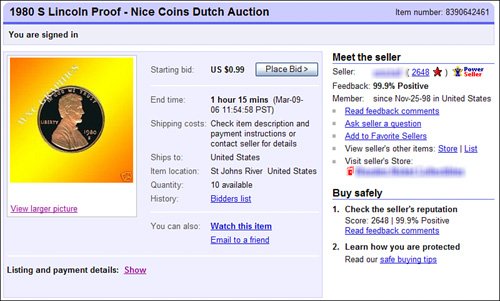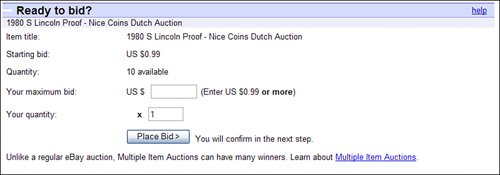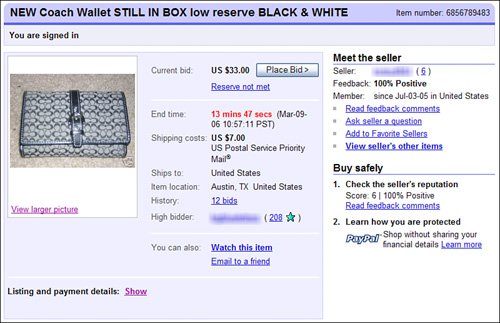Bidding in Other Types of Auctions
| The preceding section covered the typical eBay auction, one without a lot of bells and whistles. eBay offers a lot of different auction options, however, and the bidding procedure is slightly different depending on the type of auction being held. Dutch AuctionsA Dutch auction is an auction in which the seller has more than one of an item for sale. An example might be a seller with a half-dozen T-shirts (all identical), or a gross of inkjet cartridges. Although most sellers on Dutch auctions are small businesses that want to move multiple quantities of an item, you'll also find some individuals with several like items to sell. In a Dutch auction, the seller specifies both the minimum bid and the number of items available in the auction, as shown in Figure 8.8. As in a normal auction, bidders bid at or above that minimum for the itemalthough, in a Dutch auction, bidders can specify a specific quantity that they're interested in purchasing. Figure 8.8. An example of a Dutch auctionnote the quantity available. When you're bidding in a Dutch auction, you not only have to place your bid, but also have to indicate how many of the item you'd like to buy. You enter the desired amount in the Quantity box in the Ready to Bid? section of the listing page. (This boxshown in Figure 8.9appears only in Dutch auctions, not in regular auctions.) Figure 8.9. Enter the quantity you want for a Dutch auction item. Determining who "wins" a Dutch auction is a little different from determining who wins a normal auction. In a Dutch auction, the highest bidders purchase the items, but all buyers pay only the amount that matches the lowest successful bid. Dutch Auctions, by ExampleLet's work through an example. Say a seller has 10 identical copies of a particular Lord of the Rings T-shirt. The seller indicates the number of items available (10) and the minimum bid (let's say $5). Potential buyers enter their bids, which must be equal to or higher than the minimum bid of $5; each buyer also indicates the quantity (from 1 to 10) that he or she is interested in purchasing. If 11 people bid $5 each (for one shirt apiece), the first 10 bidders will win the auction, each paying $5 for their items, and the last bidder will be out of luck. But if the 11th person had placed a higher bid$6, let's saythen that 11th bidder would be listed as the #1 bidder, and the last $5 bidder (chronologically) would be knocked from the list. All 10 winning bidders, howeverincluding the person who bid $6would have to pay only $5 for the item. Highest bidders, lowest bids. Get it? In a Dutch auction, the minimum price ends up being raised only if enough bidders place bids above the minimum bid. In our example, if 9 bidders bid over the minimum, but the 10th bidder bid $5, all bidders would still pay $5. But if the lowest bid was $6 (and the other bidders bid from $6 to $10), all 10 bidders would pay $6 (the lowest current bid). So posting a higher bid increases a buyer's chances of winning an item at a Dutch auction, but it also increases the risk of raising the price for everybody. When a potential buyer bids on multiple copies of the item, those toward the end of the list may not get the quantity they desire. Still using our T-shirt example, if the top bidder wants three shirts, the remaining shirts are distributed among the next seven biddersleaving the last or lowest two bidders out in the cold. Note
Tips on Bidding in Dutch AuctionsDutch auctions actually benefit the buyer more than any other type of auction by letting higher bidders pay the lowest bid price. Should you bid on a Dutch auction? Why not? If someone is selling something you want, by all means, bid! How much should you bid? Ah, there's the issue. I actually like bidding on Dutch auctions later in the game so that I can get a handle on how many other bidders I'm competing with. The number of bidders versus the quantity of items available determines my strategy:
Reserve Price AuctionsIn a reserve price auction, the seller has reserved the option to set a second price (the reserve price) that is higher than the opening bid. At the end of an auction, if the high bid does not meet or exceed the seller's reserve price, the auction is unsuccessful and the seller does not sell the item to the high bidder. Sellers sometimes use a reserve price on high-end items if they want to make sure that the market does not undervalue what they are selling. In other words, the reserve price is the lowest price at which a seller is willing to sell an item (unrelated to the opening bid price). The seller specifies the reserve price when the item is initially listed (naturally, the reserve price should be above the minimum bid price). The reserve price is known only to the seller (and to eBay) and is seldom disclosed to bidders. A reserve price auction begins just like any other auction, at the minimum bid price. The only difference is the reserve price indication in the listing's auction details, as shown in Figure 8.10. You place your bid as you would in a normal auction, and the auction proceeds pretty much as normal. Figure 8.10. An example of a reserve auction in which the reserve price hasn't yet been met. If your maximum bid is equal to or greater than the reserve price, the item's current price is raised to the reserve price, and the reserve price has officially been met. If, through the course of the auction, the reserve price is not met, the auction ends with the item unsold. Note
Reserve Price Auctions, by ExampleLet's look at a brief example of a reserve price auction. Suppose a seller has a leather jacket to sell that she feels is worth $50but she wants to set a lower initial bid, to get the bidding going early. So the seller sets $25 as the initial bid, and $50 as the reserve price. The first bidder on this item sees the $25 initial bid (the reserve price isn't displayed, of course) and bids $25. The bidder is notified that he has the current high bid, but that the reserve price has not been met. If the auction were to end right now, the item would not be soldthe seller is obligated to sell only if the reserve price is met. The bidding continues, and the bid price increases until it hits $50. At that point, the most recent bidder is notified both that he is the high bidder and that the reserve price has been met. If the auction ends nowor at any point afterwardthe seller is obligated to sell, because the reserve price ($50) has been met. So, in this example, any bids under $50 don't win the auction; any bids $50 and over can be winning bids. Tips for Bidding in Reserve Price AuctionsIf you want to bid in a reserve price auction, what should your strategy be? It depends on how badly you want the item. If you really, really, really want the item, you should place your first bid and see whether you hit the reserve price. If you didn't, place a new, higher bid, and see whether it hits the reserve price. If you still didn't, repeat until your bid is high enough to meet or exceed the reserve price and guarantee a win. For many bidders, however, this is simply a strategy to ensure writing a large check. In most cases, play a reserve price auction as you would a normal auction, and let the high bid be the high bid. If you have the high bid and the reserve price isn't met, it's no skin off your nose; it simply means that the seller set an unreasonable reserve price. You always have the option of contacting the seller post-auction to see whether he or she is willing to sell at the current bid price, even though the reserve hasn't been met, using eBay's Second Chance Offer feature. The seller isn't obligated to do so, of course, but some might be willing to let the merchandise go to forgo starting a whole new auction (and paying another listing fee)or they may be willing to negotiate a selling price somewhere in between your bid and the reserve. You never know until you ask! Tip
|
EAN: 2147483647
Pages: 204

